You are here
Calligraphy of the ensemble Registan.
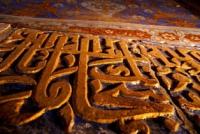
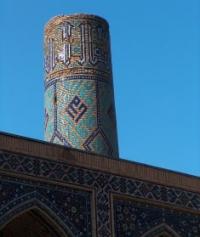
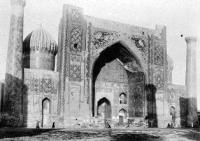
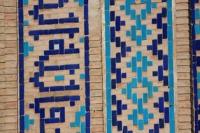
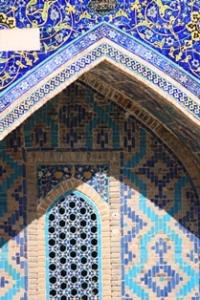
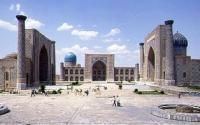
Visiting to Registan
“Spring is about to end. Summer is about to begin.
Samarkand is so careless once a year.
And the dust of centuries settles on the peaks of minarets.
And near the oriole whistles in the lilac garden "
Arkady Smirnov. “Dedication to Samarkand”.
Pilgrimage tours to Samarkand.
Among all areas of Islamic art, calligraphy (literally "beautiful letter"), which began to flourish from the earliest periods in the history of the youngest religion in the world, is the most popular. According to the sayings of the Prophet, the calligrapher who will manage to rewrite God's Word (Quran) in a beautiful hand will belong to the inhabitants of paradise.
Calligraphy is usually considered as a manifestation of the human spiritual principle in all its splendor, for the purity and magnificence of writing is a kind of expression of the integrity of the inner world of a person.
Among the hundreds of inscriptions on the architectural monuments of the Registan ensemble, medieval calligraphers used a wide variety of Arabic script styles. We will talk about some of them in more detail.
Kufi style on Registan.
The period of development of Muslim calligraphy began with a special "kufic" style. This form of writing was called “kufi” (after the city of Kufa in Iraq), and many of its features were attributed to Khazrat Ali ibn Abutalib, who was considered the patron saint of clerks and calligraphers.
The kufi form was very popular among many other forms of Islamic writing and at first was devoid of vowel sounds. Only after 686, corresponding signs were added to designate them, differing from the way in which the existing letters were written.
With the increased use of paper made according to the recipes of Chinese masters, starting in 752, in the Islamic world, the kufi writing system began to develop in several directions at once. There were different styles of writing for books and documents, in paperwork.
Initially, the full text of the Quran was rewritten on the processed animal skins with a reed pen: the pages had the shape of a rectangle with a long base, and only from the tenth century in the countries of the eastern part of the Islamic world began to rewrite the pages of the usual form.
With a change in the format of the sheet, the size of the letters changed as well: unequal, disproportionate and large letters of the original kufi became more consistent, even, proportional, and in subsequent centuries, up to the present, they are most often used for decorative purposes.
Style "Suls" on Registan.
Handwriting suls is more often used for writing titles than for the main text. Characteristic sulsa: rounded letters, often in a close arrangement, so that the elements of the letters intersect, overlap. Forms sulsa over the centuries have been modified and developed.
Many varied options have been preserved in the architectural design, in the decoration of metal products, in textiles and glass. It was also widely used for Koranic texts and inscriptions in the form of separate sayings.
Style "Nastalik" on Registan.
Nastalik (Arabic. Nasta`līq) is one of the traditional handwritings of Arabic writing. The grandsons of Tamerlane - Baysankor Mirza (died in 1434) and Ibrahim Sultan (died in 1435) were considered good calligraphers along with their scholarship and wisdom.
It should also be noted that during the reign of Baysankor Mirza in Herat (the first half of the 15th century), a new nasta'lik style spread. It corresponded to many features of Farsi, and especially poetry. The nasta'lik style became very popular in other countries, and the number of calligrapher masters who preferred this style grew.
In Turkey, India, Central Asia, Nasta'liq was considered the main style for Persian texts and texts in local languages. It differs in the truncated spelling of characters (of which only points are often left), as well as in the fact that connected elements (groups of characters) inside the word are written under a certain inclination up to the end of the element, and the next element starts again from the top of the line. In Arab countries, called the "Persian letter."
Currently, Nasta'liq is widely used only in Iran, Afghanistan and Pakistan, where it successfully competes with the traditional naskh handwriting. In Iran and Afghanistan, Nasta'liq is currently used mainly for decoration and decoration purposes (headlines, announcements, etc.), as well as in manuscripts, while the bulk of books and newspapers are typed in naskh.
In the XVIIIth and early XXth centuries, Nastalik was also widely distributed in countries with strong Persian influence (the Ottoman Empire, Central Asia, Pakistan, Afghanistan, the Uigurs inhabited the territory of China).
In countries with a predominant Arabic language, Nastalik is called “Persian writing” and is considered archaic; most Arabs read texts written by Nastalik with difficulty.
Enlightener::
Bekhruz Marufi, Rinat Abdulmanov. http://registon.uz
Photos by
Alexander Petrov.







